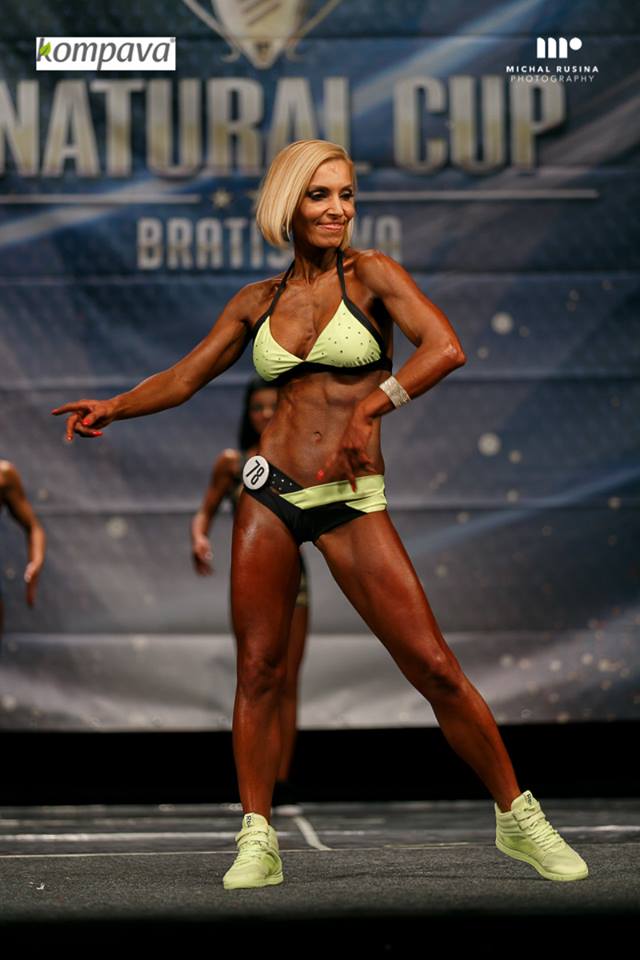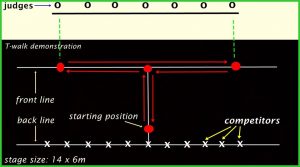
WOMEN'S SPORT MODEL
Definition of judges criteria
Basic rules of judges criteria of a natural bodybuilding
for the category Sport Model
-rules define individual parts of bodybuilding competitions (elimination, pre-judging, finals)
-how the individual parts of bodybuilding competitions are judged
Competition clothing and preparation of athletes
An athlete shows swimwear for approval at the registration.
Competition clothing:
Clothing for both rounds is determined by the following criteria:
Sports bra and shorts.
Colour, material and a structure is optional.
Shorts have to cover 1/3 of the bottom and the entire front.
Sneakers/ Running shoes – no platform.
Optional hairstyle.
Treatment of the skin is supposed to be natural and healthy tanned.
Colour used – ProTan or colour on the same basis (not DreamTan).
Stylish jewellery is allowed supposing being tasteful, sport equipment is not allowed.
The head judge is eligible to decide whether the athlete‘s clothing is acceptable in terms of standard, taste and decency.
Elimination
In case of a higher number of athletes – more than 12 in the category- an elimination is carried out.
The secretary of the head judge gives out The Elimination form to all judges. There are already written down registration numbers of athletes in each category.
A supervisor (or a stage judge) lines the athletes on the stage according to their registration number beginning with the lowest number from the left side of the stage in a row (if necessary, in two rows). Athletes stand in the basic stance. Then they perform quarter turns based on the head judge‘s instructions. Consequently,they are instructed by the head judge to change the positions i.e.starting with the lowest registration number from the right to the left and are asked to repeat quarter turns.
Semifinals (Pre – judging)
1st round – Pre – judging
-judging the physique in quarter turns
Athletes stand in a line, according to registration numbers facing judges and perform four quarter turns to the command of the head judge – “Quarter turn to the right”. Judges compare and evaluate at least two and no more than five athletes at a time. The head judge, on his own, can decide to reject or correct the individual requirements of judges for comparison. All individual comparisons will be placed in the center of the stage and in the order from the left to the right as required by judges. Each judge is eligible to submit at least one request for comparisons.
This comparison is performed as follows:
The description of four quarter turns:
Quarter turn to the right:
(Athlete stands with her left side of figure turned to judges)
Athletes stands in a relaxed and upright stance. Head and eyes are in the same position as a body, one leg slightly bent, abdominals tensed, breast forward, shoulders backward, arms not stretched, elbows bent, thumbs and fingers together, hands directed to the body, arms slightly bent. The positioning of arms causes a slight rotation of the upper body to the left, with the left shoulder lowered and the right stretched forth above.
Quarter turn with the back to the judges:
(Athlete stands with her back to the judges)
Athletes stands in a relaxed and upright stance. Head and eyes are in the same position as a body, heels together, legs stretched and together, abdominals tensed, breast forward, shoulders backward, arms not stretched, elbows bent, thumbs and fingers together, hands directed to the body, arms slightly bent.
Quarter turn to the right:
(Athlete stands with her right side of figure turned to judges)
The same as the first quarter turn to the right, the right side of figure turned to judges.
Quarter turn to the right, facing front:
Athlete stands in a relaxed and upright stance. Head and eyes are in the same position as body, heels together, legs stretched and together, abdominals tensed, breast forward, shoulders backward, arms not stretched, elbows bent, thumbs and fingers together, hands directed to the body, arms slightly bent.
Judging in the 1st round:
- Judging starts with an overall impression of the athlete. Taking into account the overall impression, femininity, overall sports muscle development. Presenting a balanced, symmetrically developed figure, the state of the epidermis and its tonus as well as the ability of an athlete to present herself with confidence and elegance.
- Figure is considered with regard to the level of overall muscle development achieved by a sports training. The muscle groups are supposed to have round and firm appearance with a small amount of body fat. The figure is not supposed to be neither excessively muscular nor excessively shredded, without a deep muscle separation and definition, it is supposed to have a ´V-shape´ (the difference between shoulder width – arms development to the width of a waist). The figure which is considered too muscular or too shredded must be judged by minus points.
- Also tightness and tonus of the epidermis is judged. The epidermis is supposed to be smooth, healthy looking and without cellulite. Face, hair and makeup should complete the overall impression of an athlete.
- Judging includes an athlete’s performance since their arrival on stage to the moment when they are leaving. At any time, an athlete in category Sport Model, must be judged with regard to healthy, athletic and fit figure, presented in an attractive overall impression.
Finals
2nd round– Finals
The best five athletes from the pre-judging round advance to the finals. They are led on the stage according to their registration numbers. Each competitor is introduced by his registration number and his name.

Sport Model T-walk
1. An athlete goes to starting position and makes the “greeting” pose.
2. An athlete goes to the front line middle position makes a “face front” pose
3. An athlete goes to the left side of the stage and makes a “quarterturn” pose, left side of the body closer to the judges.
4. An athlete goes to the right side of the stage and makes a “quarterturn” pose, right side ofthe body closer to the judges
5. An athlete goes to the front line middle position makes a pose back to the judges.
6. An athlete goes to starting position and makes the “goodbye” pose.
7. An athlete goes to back to the back line.
* No pose should be repeated in the T-walk.
Sport Model I-walk
1. An athlete goes to starting position and makes the “greeting” pose.
2. An athlete goes to the front line middle position makes all the quarter turns.
3. An athlete goes to starting position and makes the “goodbye” pose.
4. An athlete goes to back to the back line.
* No pose should be repeated in the I-walk.
Then, athletes come to the middle of the stage in a row in the order from the lowest registration number.
Subsequently, the whole row performs four quarter turns. The head judge (or a stage judge) changes the position of athletes from the highest to the lowest registration number and they perform mandatory poses again. We compare symmetry, proportionality and the shape of a physique.
After quarter turns, the finalists are asked to leave the stage.
Judgement shall be written down into the arbitration tables. The one lowest and one highest score is crossed out. Subsequent evaluation of the pre-judging and the finals multiplied by the coefficient are counted up. Athletes with lower sum of positions are in the final evaluation on a higher position. The winner is the one with the lowest sum of positions. When the sum of points is the same, the final ranking depends on the athlete‘s position in the pre-judging, respectively, in the finals.

